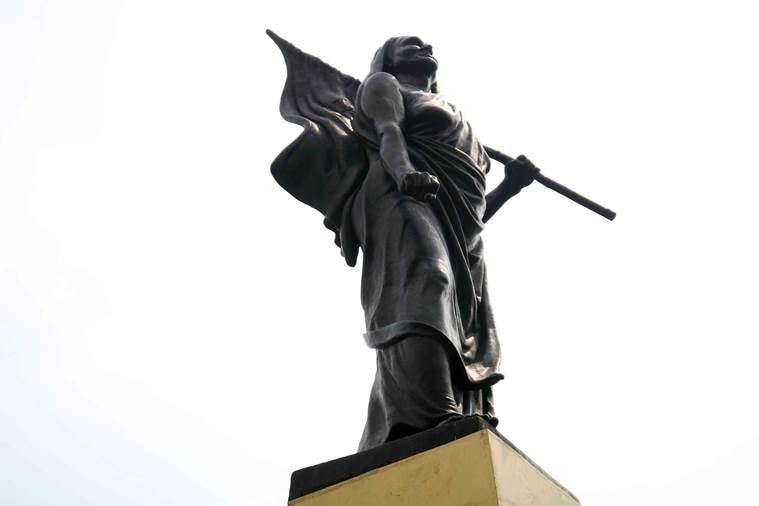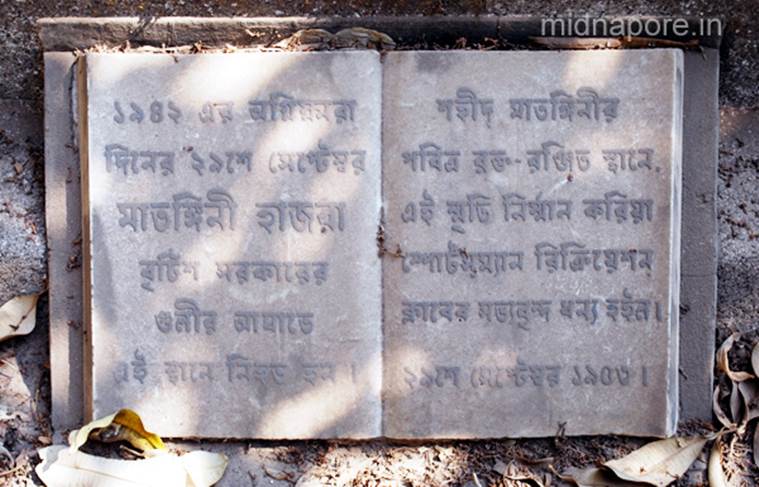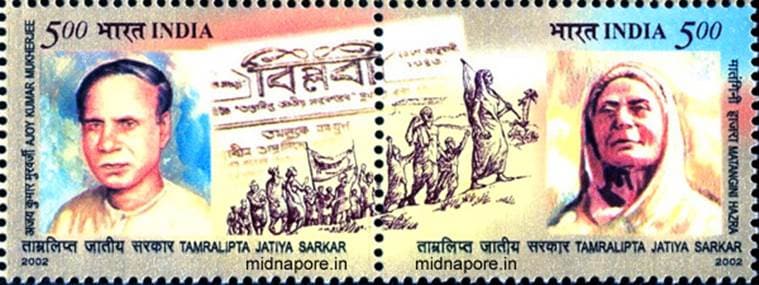 Born in a village named Hogla, near Tamluk, in 1869, Matangini Hazra was an unusual woman for her time. (Express Photo Shashi Ghosh)
Born in a village named Hogla, near Tamluk, in 1869, Matangini Hazra was an unusual woman for her time. (Express Photo Shashi Ghosh)
What does a US-based physicist have to do with a woman revolutionary in the Indian freedom struggle? On the surface, nothing at all. Yet, a reading of Indian-American scientist and author Mani Bhaumik’s book ‘Code Name God’ would show otherwise. Now, a US citizen, Bhaumik, 88, spent his childhood and college years in pre-Independence Bengal, in Tamluk, and found himself deeply influenced by three people whom he names in his writings—his grandmother, Mahatma Gandhi and a revolutionary, “an extraordinary woman” by the name of Matangini Hazra.
Born in a village named Hogla, near Tamluk, in 1869, Matangini Hazra was an unusual woman for her time. Not much information is publicly available for her early years, but according to research available in the West Bengal government archives, she was the daughter of a poor farmer who could not afford to provide her a formal education. With no means to raise a decent dowry, she found herself married at 12 to Trilochan Hazra, a 60-year-old man from Alinan village in Medinipur. By age 18, Matangini Hazra was widowed, without any children.
Following her husband’s death, she began devoting herself to working for social causes. In the early 1900s, the Nationalist movement began gaining traction across the subcontinent and Gandhi travelled extensively across the length and breadth of the region, raising awareness for the freedom movement. According to state government archives, Hazra became so inspired by Gandhi’s beliefs that she became a devoted follower of the leader, earning herself the name, “Gandhi buri”.
 One particular memory of Hazra as a staunch believer in independence stands out in Bhaumik’s writings: (Express Photo Shashi Ghosh)
One particular memory of Hazra as a staunch believer in independence stands out in Bhaumik’s writings: (Express Photo Shashi Ghosh)
In his book, Bhaumik writes: “Matangani’s love for Gandhi was so great that she became known in our village as Gandhiburi, the old Gandhian woman… it was through Matangani that I came to know his message and that my own spirit was infused. I drew courage from her story and from her practical realism…” His writings make his admiration for Hazra evident, as he devotes significant space to his memories of her and her values that percolated down to him, having lived in relative proximity to each other in the Tamluk district.
One particular memory of Hazra as a staunch believer in independence stands out in Bhaumik’s writings: “One blazing afternoon (in 1933), a freedom march was held in the district capital. Its destination was the palace of the Governor, who stood supremely and insouciantly out of reach on his balcony, observing the march as if it were some curious native custom or….cricket match…. Matangini marched in the parade’s vanguard, holding the freedom movement’s flag high. As they reached…. directly in front of the governor’s balcony, she suddenly broke through the bayoneted cordon, brandishing her banner, and screamed, “Go back, lat sahib” before the stunned soldiers could take her down.” That afternoon, British police assaulted Hazra during her protests, following which she sustained injuries.
Also read | Sarala Devi: From Tagore’s family, a leading light of the swadeshi movement
Her anti-British activism, writes Bhaumik, earned her immediate arrest and she was sentenced to six months of hard labour, an incident that physically affected the woman, leaving her haggard and malnourished after release. Despite her physical state, this staunch follower of Gandhi, went back to her social work immediately after her release to help untouchables.
Among the various parts of the subcontinent that saw movements and protests against British rule, Medinipur in Bengal stood out because of the unique roles that women in this district played in the freedom struggle through their active participation.
At the age of 61, she was arrested for taking part in the Civil Disobedience Movement in 1930 and the Salt March led by Gandhi. Her participation in the Civil Disobedience Movement led to several short stints in prison during which she came across other women revolutionaries who had also been jailed for their anti-British activities. It was during this time when she became an active member of the Indian National Congress and started spinning her own khadi in Gandhi’s footsteps.
Despite the number of times Hazra was assaulted by British authorities and imprisoned for her revolutionary work, she remained resolutely devoted to the cause of freedom from British rule. Her involvement with the freedom struggle intensified during the Quit India Movement launched by Gandhi in August 1942.
Members of the local branch of the Indian National Congress in Medinipur proposed to wrest control of local government offices and police stations in the district as the first step in the path to achieving their goals through the Quit India Movement. In September that year, a 73-year-old Hazra led a large procession of around 6,000 protesters, mostly women. The procession marched with the aim to take over the Tamluk police station from British authorities.
In the skirmish that followed between protesters and the police, Hazra stepped forward with the flag of the freedom movement in her hand, to appeal to police to not shoot at the procession. Her pleas went unheard and British police officials shot at her thrice. Despite her wounds, she continued marching with the freedom flag, chanting ‘Vande Mataram’, till she collapsed and died, the flag still clutched in her hands. According to archives of the Medinipur district government, Hazra’s killing made her a martyr for many, inciting revolutionaries to establish their own local government in Medinipur, till it was disbanded on Gandhi’s request two years later in 1944.
Matangini Hazra was not forgotten by the country for whose freedom she devoted her entire life. In 1977, the first statue in the Kolkata Maidan dedicated to a woman revolutionary was that of Matangini Hazra.
Across Bengal, several schools, neighbourhoods and streets have been named after Hazra for her contributions to the freedom struggle, including the long stretch of Hazra Road in Kolkata, a fact known to few city residents. Commemorative plaques and statues were established post-independence in Tamluk, one marking the place where she was killed by British authorities. In her birthplace of Hogla village in Purba Medinipur, a commemorative cottage was established in her memory.
 Commemorative plaques and statues were established post-independence in Tamluk, one marking the place where she was killed by British authorities. (Photo credit: Medinipur District Government)
Commemorative plaques and statues were established post-independence in Tamluk, one marking the place where she was killed by British authorities. (Photo credit: Medinipur District Government)
In 2002, India Post issued a series of commemorative stamps on the 60th anniversary of the Quit India Movement, a Rs 5 stamp featuring Matangini Hazra’s portrait. In 2015, the Shahid Matangini Hazra Government College for Women was established in Tamluk, Purba Medinipur, after the district’s most well-known revolutionary figure.
 In 2002, India Post issued a series of commemorative stamps on the 60th anniversary of the Quit India Movement, a Rs 5 stamp featuring Matangini Hazra’s portrait. (Photo credit: Medinipur District Government)
In 2002, India Post issued a series of commemorative stamps on the 60th anniversary of the Quit India Movement, a Rs 5 stamp featuring Matangini Hazra’s portrait. (Photo credit: Medinipur District Government)
On the eve of India’s 71st Independence Day in 2017, in his address to the nation, President Ram Nath Kovind remembered Hazra’s contributions to the freedom struggle, particularly the manner in which she was shot and killed by colonial police.
Remembering Matangini Hazra, the legendary freedom fighter, on her birth anniversary
— Mamata Banerjee (@MamataOfficial) October 19, 2017
The statue at Maidan shows Matangini Hazra standing tall, the flag resting on one shoulder, her right palm balled into a tight fist, her determination to fight for the cause she believed in, more visible on her face than the lines and creases of age. A fitting reminder of her remarkable story.